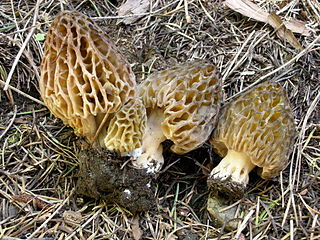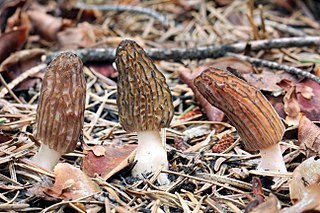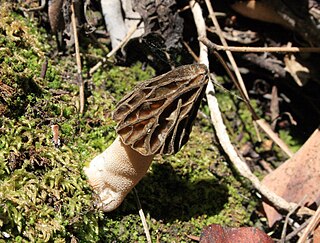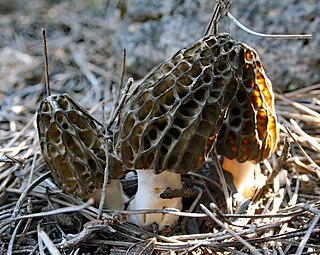
Morchella esculenta is a species of fungus in the family Morchellaceae of the Ascomycota. It is one of the most readily recognized of all the edible mushrooms and highly sought after. Each fruit body begins as a tightly compressed, grayish sponge with lighter ridges, and expands to form a large yellowish sponge with large pits and ridges raised on a large white stem. The pitted yellow-brown caps measure 2–7 centimetres broad by 2–10 cm (1–4 in) tall, and are fused to the stem at its lower margin, forming a continuous hollow. The pits are rounded and irregularly arranged. The hollow stem is typically 2–9 cm long by 2–5 cm (1–2 in) thick, and white to yellow. The fungus fruits under hardwoods and conifers during a short period in the spring, depending on the weather, and is also associated with old orchards, woods and disturbed grounds.

Amanita gemmata, commonly known as the gemmed amanita or the jonquil amanita, is an agaric mushroom of the family Amanitaceae and genus Amanita. The fruit body has a cap that is a dull to golden shade of yellow, and typically 2.5–12 centimetres in diameter. The cap surface is sticky when moist, and characterized by white warts, which are easily detached. It is initially convex, and flattens out when mature. The flesh is white and does not change colour when cut. The gills are white and closely spaced. The stem is pale yellow, and measures 4–12 cm long by 0.5–1.9 cm thick. The partial veil that covers the young fruit body turns into the ring on the stem at maturity. The spore print is white. It resembles numerous other species.

Morchella rufobrunnea, commonly known as the blushing morel, is a species of ascomycete fungus in the family Morchellaceae. A choice edible species, the fungus was described as new to science in 1998 by mycologists Gastón Guzmán and Fidel Tapia from collections made in Veracruz, Mexico. Its distribution was later revealed to be far more widespread after several DNA studies suggested that it is also present in the West Coast of the United States, Israel, Australia, Cyprus, Malta and Switzerland.
Lactarius torminosulus is a member of the large milk-cap genus Lactarius, in the order Russulales. A European species, it was officially described in 1996 from collections made in Norway. Fruit bodies (mushrooms) are small to medium-sized, yellowish orange in colour. Young specimens have a hairy cap margin; these hairs slough off in maturity—a field characteristic that can be used to help distinguish this species from the similar Lactarius torminosus. The fungus grows in a mycorrhizal association with dwarf birch species.

Morchella tridentina is a cosmopolitan species of ascomycete fungus in the family Morchellaceae. Commonly referred to as the mountain blond or western blond morel in North America, it produces conical, grey to buff fruit bodies that are rufescent and grow up to 20 cm (7.9 in) tall and 5 cm (2.0 in) wide. This early-diverging species is distinct within the /Elata clade due to its pale colours and has been described by many names in the past, including M. frustrata, M. quercus-ilicis, M. elatoides, M. elatoides var. elegans and M. conica var. pseudoeximia, all of which were shown to be synonyms. A widely distributed relict of the last Ice Age, M. tridentina is so far known from Argentina, Armenia, Chile, Cyprus, France, India, Israel, North America, Spain and Turkey.

Morchella snyderi is a species of fungus in the family Morchellaceae. Described as new to science in 2012, it occurs in the montane forests of western North America, including California, Idaho, Montana, Oregon and Washington. It produces fruit bodies up to 14 cm (5.5 in) tall with ridged and pitted conical caps, and stipes that become pitted in maturity. The color of the morel is yellow to tan when young, but the cap ridges become brown to black in maturity or when dried.

Morchella importuna is a species of fungus in the family Morchellaceae described from North America in 2012. It occurs in gardens, woodchip beds, and other urban settings of northern California and the Pacific Northwest region of the United States and Canada. The fungus has also been reported from Turkey, Spain, France, Switzerland, Canada and China, although it is unknown whether this is a result of accidental introductions. It is considered a choice edible mushroom. The fruit bodies develop a distinctive ladder-like pattern of pits and ridges on the surface of their conical caps.

Morchella sextelata is a species of ascomycete fungus in the family Morchellaceae. Described as new to science in 2012, it is found in North America. It has also been found in China, although it is not known if this is a result of an accidental introduction or natural dispersion. The fruit bodies have a roughly conical cap up to 7.5 cm (3 in) tall and 5 cm (2 in) wide, with a surface of mostly vertically arranged pits. The cap is initially yellowish to brownish, but it darkens to become almost black in maturity. The stipe is white and hollow, measuring 2–5 cm (0.8–2.0 in) high by 1–2.2 cm (0.4–0.9 in) wide.

Morchella populiphila is a species of morel fungus native to northwestern North America. Described as new to science in 2012, its specific epithet refers to its association with black cottonwood. The morel used to be referred to as Morchella semilibera in western North American field guides until molecular analysis established that to be a strictly European species. M. populiphila occurs in California, Nevada and Oregon. Its fruit bodies grow up to 15 cm (6 in) tall with a ridged and pitted conical cap that attaches about halfway down the stipe. The cap ridges are dark brown to black in maturity, while the pits are yellowish to brownish. The fungus is edible, although not as highly valued as other morels.

Morchella punctipes is a species of morel fungus in the family Morchellaceae. It is native to North America, found widely distributed east of the Rocky Mountains. It is edible when cooked.
Morchella deqinensis is a species of fungus in the family Morchellaceae found in China. It grows in coniferous and mixed forests at an elevation of 2,800–3,200 m (9,200–10,500 ft).

Boletus abruptibulbus is a species of bolete mushroom in the family Boletaceae. Described as new to science in 2009, it is found only in the Gulf Coast of the Florida Panhandle, where it grows on the ground in coastal sand dunes, one of only three North American boletes known to favor this habitat. The fruit bodies have convex brownish caps up to 8 cm (3.1 in) in diameter, supported by solid yellowish to reddish stems measuring 3–5 cm (1.2–2.0 in) long by 10–15 mm (0.4–0.6 in) thick. The pores on the underside of the cap measure about 1–2 mm in diameter and are initially pale yellow before developing a greenish tinge in age. The mushroom's spores, about 20 micrometers long, are unusually long for a member of the Boletaceae. The stem base is bulbous, a diagnostic feature for which the species is named.

Tuber lijiangense is a species of truffle in the family Tuberaceae. Found in China, it was described as a new species in 2011. Fresh truffles are pale yellow or light brown, roughly spherical, and measure up to 3 cm (1.2 in) in diameter.

Tuber microspiculatum is a species of truffle in the family Tuberaceae. Found in China, it was described as new to science in 2012. The edible species has fruit bodies up to 2.5 cm (1.0 in) wide that range in color from light yellow to reddish brown depending on their age. It is distinguished microscopically from other similar truffles by the honeycomb-like ornamentation on the surface of its spores.

Tuber sinoalbidum is a species of truffle in the family Tuberaceae. Known only from China, it was described as a new species in 2011. Fresh truffles are whitish with a similarly colored interior, and measure up to 4.5 cm (1.8 in) in diameter.

Morchella anatolica is a rare species of ascomycete fungus in the family Morchellaceae. It was described as new to science in 2010 from southwest Anatolia, Turkey, where it grows on moss-covered stream beds in pine forests. An ancient climatic relict, M. anatolica is restricted to the Mediterranean basin and has also been documented in Spain, Cyprus and Greece, where it is sometimes encountered with trees of the Oleaceae family. Together with its sister-species Morchella rufobrunnea, they are the earliest diverging lineages in genus Morchella, forming a distinct clade that is basal in global morel phylogenies. Because of its phylogenetic position, M. anatolica has been crucial in inferring the historical biogeography of the genus, which is estimated to have emerged somewhere in the Mediterranean region in the late Jurassic.

Morchella arbutiphila is a species of fungus in the family Morchellaceae (Ascomycota), described from the island of Cyprus in 2016. The species is notable for its elongated stipe, which is often longer than the cap's length, its ascospores which are larger than most other species of Morchella, and its highly specific ecological preferences. It is known only from igneous substrates of the Troodos mountains in Cyprus and from a single collection in the Aegean region of Turkey.

Morchella disparilis is an Ascomycete fungus in the family Morchellaceae. Described as new to science in 2016, M. disparilis appears to be confined to the Mediterranean basin and is so far known from Cyprus, Greece and Spain. Its most striking feature is the exceptionally deep sinus, intermediate in depth between half-free morels of the Morchella semilibera clade and typical Distantes species.

Morchella dunalii is a species of fungus in the family Morchellaceae (Ascomycota). A widespread species in the Mediterranean basin, M. dunalii is so far known from the Balearic islands, the islands of Corsica and Cyprus, France, Spain and Turkey, where it appears to be abundant. It fruits very early in the season on calcareous soil, usually in association with the Aleppo pine, Calabrian pine and holm oak.
Placolecis kunmingensis is a species of saxicolous (rock-dwelling), crustose lichen in the family Catillariaceae. It is found in Yunnan, China. The lichen is characterised by a thallus that is areolate to squamulose in its centre, forming irregular patches or clumps 10–50 mm wide, as well as its ellipsoid or spherical ascospores with slightly thickened wall.















